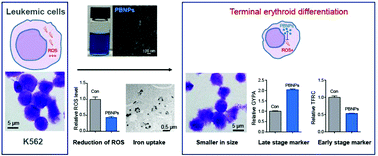Prussian blue nanoparticles induce myeloid leukemia cells to differentiate into red blood cells through nanozyme activities
Abstract
Numerous types of diseases cause serious anemia, which is characterized by a significantly decreased number of circulating red blood cells. The key reason is retarded terminal erythroid differentiation, which is largely involved in the downregulation of intracellular reactive oxygen species (ROS) and insufficient iron uptake. Prussian blue nanoparticles (PBNPs) have been demonstrated to be capable of scavenging ROS via multienzyme-like activity and contain the iron element. The aim of this study was to figure out whether PBNPs can induce terminal erythroid differentiation in myeloid leukemia cells K562 and to investigate the underlying mechanisms. Our results showed that PBNPs were taken up by K562 cells, which reduced the intracellular ROS level in the cells, upregulated the late erythroid surface marker GYPA (CD235a) and downregulated the early erythroid surface marker TFRC (CD71), clearly indicating the occurrence of terminal erythroid differentiation. In addition, the cells became smaller in size after incubation with PBNPs, providing strong side evidence that the cells had undergone terminal differentiation. Mechanistic studies indicated that PBNP-induced terminal differentiation was associated with the upregulation of the nuclear transcriptional factor NFE2 and downregulation of GATA1, both of which are closely related to the variation of intracellular ROS levels. In conclusion, PBNPs demonstrated a novel function by effectively inducing terminal erythroid differentiation in myeloid leukemia cells, which is of great significance in improving the blood profiles of anemia patients.



 Please wait while we load your content...
Please wait while we load your content...